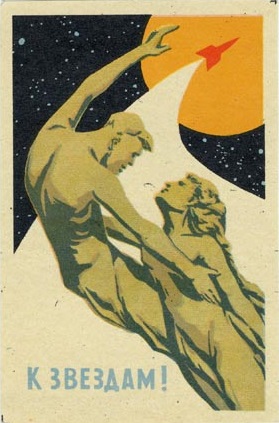Visual Cultures of Socialism
Conference at the University of Hamburg, 18 – 20 March 2015

Sowjet matchbox label from the 1960s. © Collection Monica Rüthers
Socialist visual cultures generated social and cultural codes that went far beyond the political iconographies. They defined central places for the negotiation of political and social relationships. The visual and pictorial conventions of the Soviet Union after 1945 are, alongside their transfer, the topic of the conference: The conference focuses on socialism as a central pathetic formula of the 20th century. How was socialism visually defined and represented? How was it made recognizable?
After 1945, visual cultures changed in the wake of reconstruction, the cold war, the thaw, stagnation and the period of transformation. Having been modeled after an ideal Stalinist Soviet Union in the postwar years, the socialist “brother countries” were soon forced to readapt to new slogans. Such changes (similar to the transition from avant-gardes and constructivism to socialist realism) led to ruptures on the one hand, but also – for example, in architecture and urban planning – to the coexistence of different concepts, to the simultaneity of the non-simultaneous. During periods of transition, the planning and implementation of new and old concepts existed side by side. Changes were not implemented at the same time and in the same way in different realms or in different socialist countries. Thus, disruptions remained visible and became part of the socialist city and everyday environments. Another ongoing confrontation with alternative projects and images appeared in the context of the cold war.
We seek to gain insights into the relationships between the control and production of images, the consumption of images and mass culture, the interaction between ‘high’ and ‘low’, in addition to the management of cultural and ethnic diversity in the socialist societies of the 20th century and the visual cultures tied to ruling practices.
Conference organisers: Prof. Dr. Monica Rüthers, Dr. Alexandra Köhring, Nathalie Keigel MA
The conference is open to the public on notification; please send a short mail to: marianna.zhevakina@uni-hamburg.de
Programme:
Wednesday, 18th March
9:00 – 10:00 Opening of the Conference
Panel 1
The Socialist Persona
10:00 – 11:00
Klaudija Sabo, University of Vienna
Tito – Icon of the Yugoslav Confederation
Sabine Stach, University of Leipzig
Hidden Heroes – Political martyrs in East Central Europe in the 1970s and 1980s
11:00 – 11:30 COFFEE BREAK
11:30 – 12:00
Beata Hock, GWZO Leipzig
Casualties of remembering communism: Women and their visual representation
12:00 – 12:30 Comment & Discussion
Monica Rüthers
12:30 – 14:00 LUNCH BREAK
Panel 2
Style and Material Culture
14:00 – 15:00
Kateryna Malaia, University of Wisconsin-Milwaukee
Animating Modernism: The Affective History of the Soviet Monumental 1960s
Sylvia Wölfel/ Christian Wölfel, TU Dresden
Technical Aesthetics — On the Aspiration for Designing a Socialist Material Culture
15:00 – 15:30 COFFEE BREAK
15:30 – 16:30
Elena Huber, University of Salzburg
Fashion, Media, and the Everyday Life: On the visualisation of Soviet national styles in the 1950s and 1960s
Gian Piero Piretto, University of Milan
Soviet shop windows as a world model
16:30 – 17:00
Comment & Discussion
Esther Meier, Alexandra Koehring
19:00 DINNER
Thursday, 19th March
Panel 3
Visual Mass Cultures
9:30 – 10:30
Pawe? Miedzinski,
Institute of National Remembrance, Szczecin
Color photo in Black&White – history of Central Photographic Agency
Carmen Scheide, University of St. Gallen
The visual construction of Soviet Ukraine
10:30 – 11:00 COFFEE BREAK
11:00 – 11:30
Matteo Bertelé, Ca’ Foscari University of Venice
The Soviet illustrated postcard as an object of mass culture and ideological practices
11:30 – 12:00
Comment & Discussion
Nathalie Keigel
12:00 – 13:30 LUNCH BREAK
Panel 4
Failures and Irony
13:30 – 14:30
Lucia Halder, TU Braunschweig
Teleology of Failure. Visualizations of Socialism in West-German textbooks
Christoph Lorke, WWU Münster
Thinking the Social: Social Images of “Poverty” and the Construction of “Self” and “Otherness” in GDR Society
14:30 – 15:00 COFFEE BREAK
15:00-16:00
Christine Gölz, GWZO Leipzig
Merry Pictures of the Little Folk: The Cartoon Magazine “Veselye kartinki”, or What’s Left from the Socialist “Children’s World”
Micha Braun, University of Leipzig
Surrealistic Mimicry. Practices of Repetition and Imitation in Eastern European Performative Arts of the 1970s and ’80s
16:00 – 16:30
Comment & Discussion
Klara Pinerová
18:00 EVENING LECTURE
Nadine Siegert, University of Bayreuth
Images of nostalgic and utopian socialism: visuality and counter-visuality in Angola & Mozambique
20:00 DINNER
Friday, 20th March
Panel 5
Folklore
9:30 – 10:30
Odeta Mikstaite, University of Greifswald
Performing the Village: “Authenticity” and rural aesthetics in the Soviet Lithuanian Ensemble Movement
Anna G. Piotrowska, Jagiellonian University, Cracow
Embodying ‘socialist emotions’ via image and music – The case of Polish state folk groups “Mazowsze” and “?l?sk”
10:30-11 COFFEE BREAK
11 – 11:30
Comment & Discussion
Ekaterina Emeliantseva
11:30 – 12:00
Closing remarks – END
University of Hamburg, Edmund Siemers Allee 1, 20146 Hamburg, ESA East Room 221

